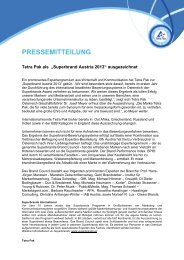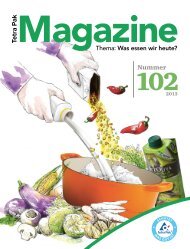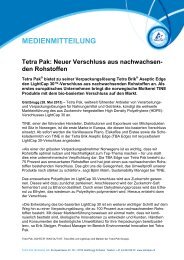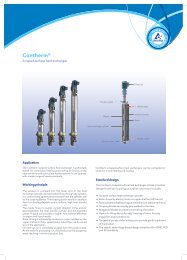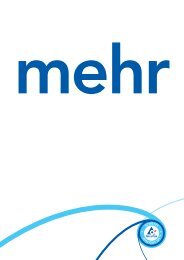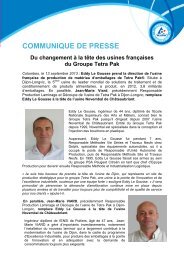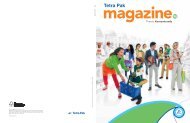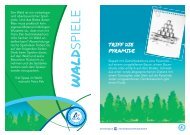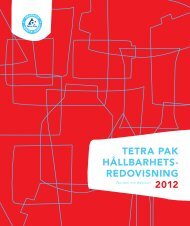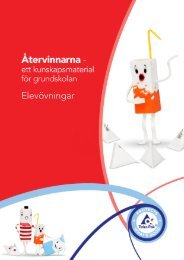tetra recart 21st century alternative to the can - Tetra Pak
tetra recart 21st century alternative to the can - Tetra Pak
tetra recart 21st century alternative to the can - Tetra Pak
Create successful ePaper yourself
Turn your PDF publications into a flip-book with our unique Google optimized e-Paper software.
TETRA RECART<br />
21 ST CENTURY<br />
ALTERNATIVE TO THE<br />
CAN
<strong>Tetra</strong> <strong>Pak</strong><br />
Who are we?
Global Company<br />
Present in more than 170 countries across 5 continents<br />
157 billion packs sold in 2010<br />
9,048 filling machines in operation in 2010<br />
42 packaging material plants<br />
11 R&D units<br />
Net Sales: 10.4 billion Euros<br />
21,672 employees
“Protect What’s Good - That’s our promise,<br />
which goes beyond our commitment <strong>to</strong> develop products that make<br />
food safer with minimum impact on <strong>the</strong> environment. It translates our<br />
passion for cus<strong>to</strong>mer success, our passion for product quality &<br />
innovation, and our passion for doing what’s good and helping protect<br />
<strong>the</strong> environment for future generations”.
Innovation<br />
Innovation is not what you think:<br />
It’s actually how you deliver new<br />
solutions <strong>to</strong> current consumers demand<br />
Breakthrough Technology<br />
OUR PASSION FOR PRODUCT PROTECTION<br />
AND INNOVATION
What is <strong>Tetra</strong> Recart
The <strong>21st</strong> Century Alternative for Canned Food<br />
Food Car<strong>to</strong>n Re<strong>to</strong>rting
Our Portfolio Today<br />
TPR1 Line<br />
24 000 pph<br />
200ml (7oz),<br />
340ml (11.5),<br />
390ml (13.5),<br />
500ml (17.5)<br />
TPR2 Line<br />
6 000 pph
<strong>Tetra</strong> <strong>Pak</strong> R1<br />
Accelerate your business in<strong>to</strong> <strong>the</strong> future<br />
TPR1<br />
TRC 340 Midi<br />
TRC 390 Midi<br />
TRC 500 Midi<br />
• 9000 - 24 000 pph<br />
• Low operating costs<br />
• Size change over time 8 hours<br />
• Flexible filler configuration<br />
• Easy <strong>to</strong> operate<br />
• Au<strong>to</strong>matic car<strong>to</strong>n loader<br />
Package Heat treatment<br />
Static re<strong>to</strong>rt<br />
Static re<strong>to</strong>rt<br />
Pasteurization<br />
Pasteurization<br />
Static re<strong>to</strong>rt Pasteurization
<strong>Tetra</strong> <strong>Pak</strong> R2<br />
The compact, flexible, lower investment solution<br />
TPR2<br />
TRC 200 Mini<br />
• 6 000 pph<br />
• Lower initial investment cost<br />
• Size change over time 30 min*<br />
• Easy <strong>to</strong> operate<br />
TRC 340 Midi<br />
TRC 390 Midi<br />
TRC 500 Midi<br />
Package Heat treatment<br />
*Within same bot<strong>to</strong>m format<br />
Static re<strong>to</strong>rt<br />
Static re<strong>to</strong>rt<br />
Static re<strong>to</strong>rt<br />
Static re<strong>to</strong>rt
Source: <strong>Tetra</strong> <strong>Pak</strong><br />
Global Brands in <strong>Tetra</strong> Recart<br />
National and Retail Brands across multiple categories<br />
33 retail brands<br />
66 brands
Protenergy Natural Foods<br />
Kerry Foods<br />
Pacific Foods<br />
Herdez-Del Fuerte (x2)<br />
Watt’s<br />
Coniexpress<br />
Camil<br />
Brasfrigo (x2)<br />
Installed Base – 26 lines<br />
5 additional lines in 2010<br />
Bonduelle<br />
Carbonell<br />
Horticoalba<br />
Jealsa<br />
Columbus (x2)<br />
Conserve Italia<br />
A Russo (x2)<br />
Copador<br />
Boschi<br />
Doggy (x2)<br />
Pamapol<br />
Al Rabie<br />
Del Monte
Market performance 2010<br />
Solid performance in all categories introduced across Europe<br />
Vegetables<br />
4%<br />
Mexico<br />
Salsas<br />
3%<br />
YTD Nov YTD Nov<br />
Brazil<br />
Vegetables<br />
8%<br />
YTD Sep<br />
UK<br />
Toma<strong>to</strong>es<br />
4 %<br />
YTD Dec<br />
17 %<br />
Italy<br />
20%<br />
Beans Vegetables Sauces<br />
Sweden<br />
Beans Toma<strong>to</strong>es Pet Food<br />
10% 3%<br />
YTD Nov YTD Nov YTD Oct<br />
23%<br />
5%<br />
Sauces<br />
18%<br />
YTD Sep YTD Sep YTD Sep YTD Sep<br />
Sources: Brazil Nielsen Homes<strong>can</strong> Q3 2010 kTonnes<br />
Mexico Nielsen Nov 2010 kTonnes<br />
Sweden, petfood, Nielsen w36 2010 kTonnes<br />
Sweden <strong>to</strong>ma<strong>to</strong>es, Nielsen w36 2010 & Euromoni<strong>to</strong>r 2010 kTonnes<br />
Sweden, beans, Niielsen w36 2010 kTonnes<br />
UK TP sales & Euromoni<strong>to</strong>r w52 2010 kTonnes<br />
Italy vegetables, IRI Nov 2010 kTonnes<br />
Italy sauces, IRI Oct 2010 kTonnes
Step change in cus<strong>to</strong>mer market performance, and share<br />
of TRC system within cus<strong>to</strong>mer portfolio<br />
Italy- Veg<br />
Italy- Beans<br />
46<br />
44<br />
42<br />
40<br />
38<br />
36<br />
46<br />
41<br />
36<br />
43.4%<br />
45.5%<br />
2009 2010<br />
45.8%<br />
49.1%<br />
2009 2010<br />
GoGreen<br />
15<br />
10<br />
8<br />
6<br />
4<br />
2<br />
0<br />
Doggy<br />
5<br />
0<br />
0.0%<br />
2006 2010<br />
3.7%<br />
13.0%<br />
7.0%<br />
2009 2010<br />
Source: YTD retail sales, kTonnes, IRI and Nielsen 2010
The GoGreen Case in Sweden<br />
Sustained growth through innovation<br />
Young , modern brand<br />
since 2004<br />
simplicity<br />
Strong brand equity<br />
Perceived as <strong>the</strong> leader in<br />
‘Good For You’ Products –<br />
Non Dairy, Dry Beans …<br />
Launch 2006<br />
Brings Innovation <strong>to</strong> <strong>the</strong><br />
category<br />
Category innovation<br />
Bean Salsas – add value<br />
12.90 SEK<br />
3 SKU’s @12.90 SEK<br />
Standard range<br />
Build volume<br />
12 SKU’s @10.90 SEK<br />
Extensively Marketed<br />
through all channels<br />
0%<br />
0%<br />
Established brand<br />
Nov 2006<br />
Source: Nielsen, MS beans category,<br />
<strong>to</strong>tal Sweden by <strong>to</strong>nnage<br />
Result<br />
2010<br />
Innovation:<br />
Drives Trial, creates loyalty<br />
Gogreen’s product mix (value):<br />
57%<br />
43%<br />
13%<br />
Standard<br />
range<br />
SALSA<br />
3 SKUs<br />
Organic<br />
Motivating<br />
Continuous<br />
Innovation<br />
Sauces<br />
Marinated
Numerous consumer studies find recurring<br />
<strong>the</strong>mes<br />
<strong>Tetra</strong> Recart supports innovation in foods category<br />
25 countries<br />
10 different<br />
markets<br />
>90 consumer<br />
studies<br />
>50 concepts
Strong consumer preference <strong>to</strong>wards<br />
car<strong>to</strong>n<br />
Reasons for preference in select countries<br />
USA UK Sweden<br />
•Fresh<br />
•Easy <strong>to</strong> handle<br />
Toma<strong>to</strong><br />
68%*<br />
•Easy <strong>to</strong> s<strong>to</strong>re<br />
•No tin taste<br />
Toma<strong>to</strong><br />
59%*<br />
Brazil Spain<br />
•Easy <strong>to</strong> open<br />
Vegeta<br />
bles<br />
86%*<br />
•Easy <strong>to</strong> handle<br />
•Easy <strong>to</strong> s<strong>to</strong>re<br />
Source: Gfk Quantitative research, 2007<br />
Tuna<br />
77%*<br />
•Easy <strong>to</strong> s<strong>to</strong>re<br />
•Environment<br />
•Easy <strong>to</strong> handle<br />
•Environment<br />
•Hygienic<br />
Reasons for car<strong>to</strong>n preference – Top 3<br />
spontaneous mentions<br />
Beans<br />
89%*<br />
Saudi<br />
Arabia<br />
Beans<br />
93%*<br />
*% who prefer <strong>Tetra</strong> Recart (compared <strong>to</strong> <strong>the</strong> <strong>can</strong>) of those<br />
who have bought it at least once<br />
•Environment<br />
•Easy <strong>to</strong> handle<br />
•Easy waste<br />
separation/recycling<br />
•Health image<br />
•Easy <strong>to</strong> open<br />
•Easy <strong>to</strong> s<strong>to</strong>re
<strong>Tetra</strong> Recart Consumer Perception<br />
A Global Summary<br />
Fresh<br />
Hygienic<br />
Freshness – no metallic<br />
taste<br />
Natural<br />
Association <strong>to</strong> healthy<br />
food<br />
Environmentally<br />
sound<br />
Environment image<br />
Recyclable<br />
Safe<br />
Preserves well<br />
No sharp edges<br />
Source: >80 consumer research studies<br />
Convenient<br />
Easy <strong>to</strong> open<br />
Efficient <strong>to</strong> s<strong>to</strong>re/stack<br />
Can s<strong>to</strong>re residual<br />
product in <strong>the</strong> package<br />
Modern &<br />
Innovative<br />
Modern<br />
Innovative
US Soup Aisle<br />
Landscape
Category has struggled <strong>to</strong> grow<br />
Despite supporting trends in Wealth & Wellness and In-<br />
Home Cooking innovation could not be sustained<br />
Stagnant<br />
Category<br />
• 5.3% sales growth<br />
from 2007-2009 driven<br />
by RTS broth,<br />
condensed wet soup, &<br />
dry soup (yakisoba)<br />
• Yakisoba (dry soup)<br />
and Private Label (all<br />
sub-segments) drove<br />
this growth<br />
Source: Mintel 2010<br />
Innovation<br />
• Health & Wellness<br />
(Select Harvest +335%;<br />
V8 +248% 2008-2009)<br />
• Product launches<br />
leveraging restaurant<br />
or celeb. Chef quality<br />
equity<br />
• Packaging trends<br />
support eco-friendly<br />
and portability<br />
lifestyle(weekday<br />
lunch is most popular<br />
eating occasion)<br />
Recession<br />
Impact<br />
• Increase in in-home<br />
cooking and usage of<br />
soup as an ingredient<br />
• Consumers seeking<br />
most value at lowest<br />
price causing <strong>the</strong>m <strong>to</strong><br />
“trade down” <strong>to</strong><br />
Retail Brands (PL RTS<br />
+18.8%; PL Condsd<br />
+10.6% 2008-2009)<br />
• Increase in destination<br />
shopping at Mass<br />
Merchants
Car<strong>to</strong>n broth has been <strong>the</strong> most signifi<strong>can</strong>t<br />
contribu<strong>to</strong>r <strong>to</strong> retailer profitability, up by 86%<br />
RTS Canned Soup has seen a decline during <strong>the</strong> same period<br />
Per S<strong>to</strong>re Weekly Adjusted Gross Profit By Soup Segment<br />
$800<br />
$700<br />
$600<br />
$500<br />
$400<br />
$300<br />
$200<br />
$100<br />
$-<br />
2007<br />
2009/2010<br />
Boullion Car<strong>to</strong>n<br />
Broth<br />
Canned<br />
Broth<br />
Condsd<br />
Soup<br />
Ramen<br />
Noodles<br />
RTS<br />
Soup<br />
Car<strong>to</strong>n<br />
RTS Dry<br />
Soup Mixes or<br />
Canned Bases<br />
Adjusted Gross Profit= Gross Profit plus all trade and term dollars<br />
2007 SuperStudy retailers: Jewel-Osco, Ralph’s, and Giant Carlisle<br />
2009/2010 SuperStudy retailers: Jewel-Osco, Safeway, Kroger, S<strong>to</strong>p and Shop, and Roche Bros.<br />
10% increase in car<strong>to</strong>n broth skus<br />
drove 62% increase in per s<strong>to</strong>re<br />
weekly sales over <strong>the</strong> past 3 years<br />
2007 2009 / 2010<br />
% of Aseptic SKUs in Broth 60.3% 70.1%<br />
Average Broth Sales $631 $1,024
Car<strong>to</strong>n Stimulates Broth Category<br />
While unit share has grown <strong>to</strong> 35%<br />
dollar share of aseptic car<strong>to</strong>n has surpassed 50%<br />
1.2<br />
1.0<br />
0.8<br />
0.6<br />
0.4<br />
0.2<br />
0.0<br />
Share of Units Sold – Broth Category<br />
90.6% 86.9% 83.2% 78.0% 72.0% 67.0% 65.0%<br />
9.4% 13.1% 16.7% 21.9% 28.0% 33.0% 35.0%<br />
Aseptic Can
Aseptic car<strong>to</strong>n has consistently<br />
brought new users <strong>to</strong> <strong>the</strong> category<br />
14<br />
18<br />
26<br />
Broth household penetration<br />
28<br />
41<br />
42<br />
40<br />
Aseptic HH Pen Can HH Pen<br />
38<br />
52 wks ending Dec 06<br />
52 wks ending Dec 07<br />
52 wks ending Dec 08<br />
52 wks ending Dec 09<br />
Source: Nielsen Homes<strong>can</strong>
A Summary | Key success drivers in broth<br />
Early Entry By<br />
Brand Leader<br />
Format supported new usage<br />
occasion & communication<br />
1<br />
4<br />
Size Differentiation<br />
(32oz car<strong>to</strong>n vs 14.5 oz <strong>can</strong>)<br />
Mainstream<br />
32 ounces 14.5 ounces<br />
Aisle Penetration with<br />
multiple brands<br />
Natural/Organic<br />
Chefs<br />
2<br />
3
US Soup Market Activity<br />
100+ skus during 2010 Soup season
Successful natural / organic branded<br />
launches
Strong Repsonse from Retailers<br />
Building <strong>the</strong> ”New Category” Range
US Consumers Recognize<br />
<strong>Tetra</strong> Recart Value Proposition<br />
Fresh, Natural, Convenient<br />
1.<br />
► People buy premium soup for a<br />
superior product<br />
► Soup in <strong>Tetra</strong> Recart is perceived <strong>to</strong><br />
deliver a fresher, more natural<br />
tasting product than <strong>can</strong> be<br />
delivered in a <strong>can</strong><br />
► Convenience is <strong>the</strong> second<br />
advantage of <strong>Tetra</strong> Recart over <strong>the</strong><br />
<strong>can</strong>:<br />
– Easier <strong>to</strong> open, <strong>to</strong> pour and <strong>to</strong><br />
reclose<br />
– Easier <strong>to</strong> dispose of and “greener”<br />
Each segment in both channels recognizes and<br />
responds <strong>to</strong> <strong>Tetra</strong> Recart’s value proposition for soup<br />
Natural Channel<br />
Car<strong>to</strong>n Users<br />
Traditional S<strong>to</strong>re<br />
Car<strong>to</strong>n Users<br />
Natural Channel<br />
Can Users<br />
Traditional S<strong>to</strong>re<br />
Can Users<br />
Prefer <strong>Tetra</strong> Recart No Preference Prefer Can<br />
54%<br />
51%<br />
60%<br />
58%<br />
0% 20% 40% 60% 80% 100%<br />
Q: Which of <strong>the</strong>se two brands do you prefer?<br />
7%<br />
12%<br />
8%<br />
12%<br />
39%<br />
32%<br />
37%<br />
30%
MULTI PACK<br />
► Over half of soup consumers say <strong>the</strong>y<br />
S<strong>to</strong>ck up on soup. 58% do so regardless<br />
of sale activity.<br />
HEALTH AND WELLNESS<br />
► When purchasing consumers state that<br />
promotion/sale and <strong>the</strong> product’s<br />
health/wellness benefits are <strong>to</strong>p reasons<br />
<strong>to</strong> purchase.<br />
BPA FREE<br />
Innovation Driven by Consumer<br />
Purchase Patterns<br />
► Among <strong>to</strong>tal consumers, roughly 40% are<br />
aware of BPA, and half of those BPAaware<br />
consumers are concerned about it.<br />
25%<br />
21%<br />
Only purchase when on<br />
sale<br />
Purchase When Needed or S<strong>to</strong>ck Up<br />
58%<br />
58%<br />
50%<br />
58%<br />
25%<br />
22%<br />
S<strong>to</strong>ck up on soup Purchase it when I need<br />
it<br />
S<strong>to</strong>cking Up Behavior<br />
43%<br />
42%<br />
I alw ays s<strong>to</strong>ck up w hen I shop<br />
for category<br />
I only s<strong>to</strong>ck up if <strong>the</strong>re is a sale<br />
Ready <strong>to</strong> eat Condensed
Innovation Driven By Consumption Patterns<br />
Upsize on Top Skus<br />
Chicken<br />
Noodle<br />
Vegetable<br />
Beef with<br />
Vegetables<br />
Chicken with<br />
Rice<br />
Chicken<br />
Vegetable<br />
Flavors Typically Eat<br />
Ready <strong>to</strong> Eat Condensed<br />
37%<br />
37%<br />
84%<br />
45%<br />
48%<br />
57%<br />
49%<br />
By itself as a meal<br />
for myself<br />
Cream of<br />
Mushroom<br />
Toma<strong>to</strong><br />
Cream of<br />
Chicken<br />
Chicken<br />
Noodle<br />
Cream of<br />
Celery<br />
29%<br />
By itself as a meal<br />
f or my f amily<br />
35%<br />
43%<br />
52%<br />
58%<br />
26%<br />
21% 23%<br />
62%<br />
Typical Product Use<br />
11%<br />
Consumers<br />
typically eat <strong>the</strong><br />
entire <strong>can</strong> when<br />
using.<br />
71%<br />
As a side dish In a recipe or <strong>to</strong> add<br />
o<strong>the</strong>r ingredients <strong>to</strong><br />
16%<br />
10%<br />
As a snack<br />
Ready <strong>to</strong> eat Condensed<br />
Consumers<br />
typically use an<br />
average of 2<br />
<strong>can</strong>s at a time.
2.<br />
Leverage Points of Differentiation<br />
•Fresher taste<br />
•Good s<strong>to</strong>rage<br />
•Light weight<br />
”associate it <strong>to</strong> broth”<br />
”less processed than <strong>can</strong>s<br />
and won’t have that metal<br />
taste”<br />
”<strong>the</strong> box looks smaller”<br />
•Familiar<br />
•Cheap<br />
•Sturdy<br />
•Home made<br />
•High quality<br />
•Visibility<br />
•For dry soups<br />
•Light<br />
”Good old <strong>can</strong>s”<br />
”Metal taste”<br />
”Lower quality<br />
ingredients”<br />
”More gourmet”<br />
”They are higher<br />
end soups”<br />
”Institutional<br />
looking”<br />
”Space food”<br />
”Army food”<br />
”Unappetising”
The Benefits of Being<br />
Perfectly Square
Supply chain cost savings<br />
Stem from a number of fac<strong>to</strong>rs<br />
+18%<br />
+15% more<br />
packs per truck<br />
More Packs Per Pallet Weight efficiency Tray Design
Glass jar<br />
Steel Can<br />
<strong>Tetra</strong> Recart<br />
A light weight package<br />
PM weight for 400g packages<br />
<strong>Tetra</strong> Recart<br />
18 g<br />
50 g<br />
200 g<br />
For every 1 million <strong>can</strong>s, 32 <strong>to</strong>ns less packaging<br />
For every 1 million jars, 182 <strong>to</strong>ns less packaging<br />
Conversion from steel <strong>can</strong><br />
<strong>to</strong> <strong>Tetra</strong> Recart reduces<br />
package weight with 64%
Efficient transportation<br />
More filled packs per pallet and truck<br />
Packs per pallet<br />
Packs per truck<br />
400g <strong>can</strong> Tray: 3x4 TRC 390 Tray: 2x6<br />
1 560<br />
1250 1167<br />
EUR pallet EUR pallet<br />
+18%<br />
49 920 +15%<br />
European conditions: 40 <strong>to</strong>n truck<br />
1 836<br />
56 916
Tray design<br />
Efficient handling in <strong>the</strong> s<strong>to</strong>re<br />
In-s<strong>to</strong>re handling time* (s/tray)<br />
Can 400g, 3x4 low tray +<br />
shrink-wrap<br />
<strong>Tetra</strong> Recart 390ml,<br />
Open <strong>to</strong>p tray, 2x8<br />
7,6<br />
14,4<br />
5,3<br />
3,0<br />
6,4<br />
15,9<br />
3,1<br />
-33%<br />
23,9<br />
Tray opening<br />
Tray shelf placement<br />
Waste handling<br />
• Easy <strong>to</strong> open tray – just rip off <strong>the</strong> front<br />
• No shrink-wrap that takes time <strong>to</strong> remove<br />
• More stable and compact tray <strong>to</strong> handle once opened<br />
• Made out of one material – cardboard – for more efficient waste handling<br />
Source: STFI Packforsk, Tray handling study 2007, Sweden<br />
*Note: Indicational figures only due <strong>to</strong> low base = 10 <strong>can</strong>ned food replenishers from retail trade
A forward-facing package…<br />
Can shelf TRC shelf<br />
More efficient merchandising<br />
•No <strong>can</strong>-turning necessary<br />
Shelf impact<br />
Always facing <strong>the</strong><br />
consumer<br />
Billboard effect<br />
100% printable<br />
package<br />
Easier for consumers <strong>to</strong> locate & shop
…that creates an impact<br />
Always facing <strong>the</strong><br />
consumer<br />
Billboard effect<br />
100% printable<br />
package
Increase On-Shelf Inven<strong>to</strong>ry<br />
Aseptic car<strong>to</strong>ns would allow retailers <strong>to</strong> s<strong>to</strong>ck 39 more units of<br />
soup in 4 feet of space than <strong>can</strong>s<br />
18.6 oz. RTS Canned Soup<br />
24 <strong>can</strong>s per facing x 9 facings per 4-foot shelf=<br />
216 <strong>can</strong>s per 4-foot shelf<br />
Willard Bishop 2010 Profitability Study<br />
18.3 oz. RTS Aseptic Soup<br />
15 facings per 4-foot shelf x 17 car<strong>to</strong>ns per facing<br />
(11 stand-ups + 6 laydowns)=<br />
255 car<strong>to</strong>ns per 4-foot shelf
Increase On-Shelf Variety<br />
Considering <strong>the</strong> higher shelves required <strong>to</strong> support <strong>the</strong> racks,<br />
aseptic car<strong>to</strong>ns could more than double space in a 4-ft set<br />
18.6 oz. RTS Canned Soup<br />
216 <strong>can</strong>s per shelf x 4 shelves=<br />
864 <strong>can</strong>s per four-foot set<br />
Willard Bishop 2010 Profitability Study<br />
18.3 oz. RTS Aseptic Soup<br />
255 car<strong>to</strong>ns per shelf x 7 shelves=<br />
1,785 car<strong>to</strong>ns per four-foot set
Out-of-S<strong>to</strong>ck Impact: Can vs. Car<strong>to</strong>n<br />
Weekly sales losses from out-of-s<strong>to</strong>cks could be trimmed in half<br />
Car<strong>to</strong>ns could cut lost sales from out-of-s<strong>to</strong>cks by over $5<br />
million for retailer with 2500 s<strong>to</strong>res<br />
Value of Aseptic Cube Efficiencies On Out-of-S<strong>to</strong>cks<br />
S<strong>to</strong>re Out-of-S<strong>to</strong>ck Average 8.0% Industry Standard O-O-S Avg<br />
Walk Rate 40.0% Industry Standard Walk Rate<br />
Approximate Lost Sales 3.2%<br />
Weekly RTS Sales per S<strong>to</strong>re $2,467<br />
Estimated Weekly Lost Sales $78.96 (3.2% of RTS Sales)<br />
Estimated Weekly Lost Sales $39.48 (1.6% of RTS Sales)<br />
Willard Bishop 2010 Profitability Study<br />
2009/2010 SuperStudy retailers: Jewel-Osco, Safeway, Kroger, S<strong>to</strong>p and Shop, and Roche Bros.
Shelf Efficiency Case Study<br />
Walmart Supercenter – Dallas, TX<br />
RTS and Condensed Real Estate within Soup Aisle<br />
Fixture capacity = 9277 Units<br />
►CO2 emission from production of raw primary packaging materials over whole fixture = 3113 lbs<br />
►Weight of primary packaging over whole fixture = 1124 lbs<br />
JDH Solutions Ltd, UK Soup and Vegetable Shelf Efficiency Study, Feb 2011
Shelf Efficiency<br />
Convert all <strong>can</strong>s <strong>to</strong> car<strong>to</strong>ns: 15% more units and 16.6 linear free released<br />
Fixture capacity = 10,729 Units<br />
►15% more capacity than original (all <strong>can</strong>s)<br />
►Total space released = 58 facings = 16.6 linear feet<br />
JDH Solutions Ltd, UK Soup and Vegetable Shelf Efficiency Study, Feb 2011
Shelf Efficiency<br />
Insert New Variety In<strong>to</strong> Released Space<br />
Fixture capacity = 12,116 units<br />
►30.5% increase in unit capacity<br />
►58 additional facings<br />
►66% reduction in CO2 emission from primary package material<br />
►51% reduction in weight of primary package material<br />
JDH Solutions Ltd, UK Soup and Vegetable Shelf Efficiency Study, Feb 2011
Soup Category<br />
Car<strong>to</strong>n Vs Can HH Penetration at Retailer X<br />
• Soup Car<strong>to</strong>n products are experiencing faster HH Penetration growth rate<br />
Vs Can<br />
• The % of HH repeating Soup Car<strong>to</strong>n products purchases increased while<br />
Can remained relatively flat in <strong>the</strong> latest 52 Wks<br />
47.3<br />
+1.0<br />
48.3<br />
16.6<br />
+3.3<br />
19.9<br />
Soup - Can Soup - Car<strong>to</strong>n<br />
% HH Buying - YA % HH Buying - TY<br />
+0.5<br />
Source: SymphonyIRI Group National Consumer Panel Data. Shopper Insights Advantage ILD: 52 weeks ending 2/20/11;<br />
74.5<br />
75<br />
45.0<br />
+5.1<br />
50.1<br />
Soup - Can Soup - Car<strong>to</strong>n<br />
% of Buyers 2x+ Buyers - YA % of Buyers 2x+ Buyers - TY
Environmental Profile<br />
<strong>Tetra</strong> Recart shows positive LCA performance<br />
Low weight<br />
Transport efficient<br />
High proportion<br />
renewable material<br />
High proportion<br />
renewable energy<br />
Global warming potential<br />
(Kg CO2 per 1000 packs)<br />
300<br />
250<br />
200<br />
150<br />
100<br />
50<br />
0<br />
<strong>Tetra</strong> Recart<br />
Tin <strong>can</strong><br />
Stand up pouch<br />
Glass jar<br />
0 10 20 30 40 50 60<br />
Fossil resource use<br />
(Kg crude oil per 1000 packs)<br />
Source: IFEU Gmbh 2006, “LCA for <strong>Tetra</strong> Recart and competitive packs in Germany”, Peer reviewed study<br />
Alu <strong>can</strong><br />
Energy<br />
demand
<strong>Tetra</strong> Recart is FSC-certified<br />
Car<strong>to</strong>n Recycling Reaches Miles<strong>to</strong>ne!<br />
In January 2011, consumer access <strong>to</strong> car<strong>to</strong>n recycling<br />
reaches 30% in <strong>the</strong> US<br />
– FSC<br />
Forest Stewardship Council<br />
certification ensures that <strong>the</strong><br />
paperboard comes from wellmanaged<br />
and controlled sources
Household Recycling Access<br />
Results <strong>to</strong> Date<br />
30.6
Retailer<br />
Benefits<br />
Consumer Benefits<br />
Environment<br />
Benefits<br />
Why <strong>Tetra</strong> Recart?<br />
Exponential Gains Across Value Chain<br />
Shelf space saving<br />
-30-40%<br />
Renewability Carbon<br />
footprint<br />
Shelf impact<br />
Waste<br />
reduction<br />
Packs per pallet/truck<br />
+18%<br />
+15%<br />
Convenient Fresh/Natural Light Weight
<strong>Tetra</strong> Recart Resouces<br />
For More Information Contact:<br />
Blaine Johnson, Sr. Sales Executive<br />
(940) 565-8983<br />
Blaine.Johnson@<strong>tetra</strong>pak.com<br />
Patty Mathison, Sales Executive<br />
(940) 565-8790<br />
Patty.Mathison@<strong>tetra</strong>pak.com<br />
Mary Therese Williams, Category Manager<br />
Food & Wine<br />
(847) 955-6487<br />
Mary<strong>the</strong>rese.Williams@<strong>tetra</strong>pak.com



